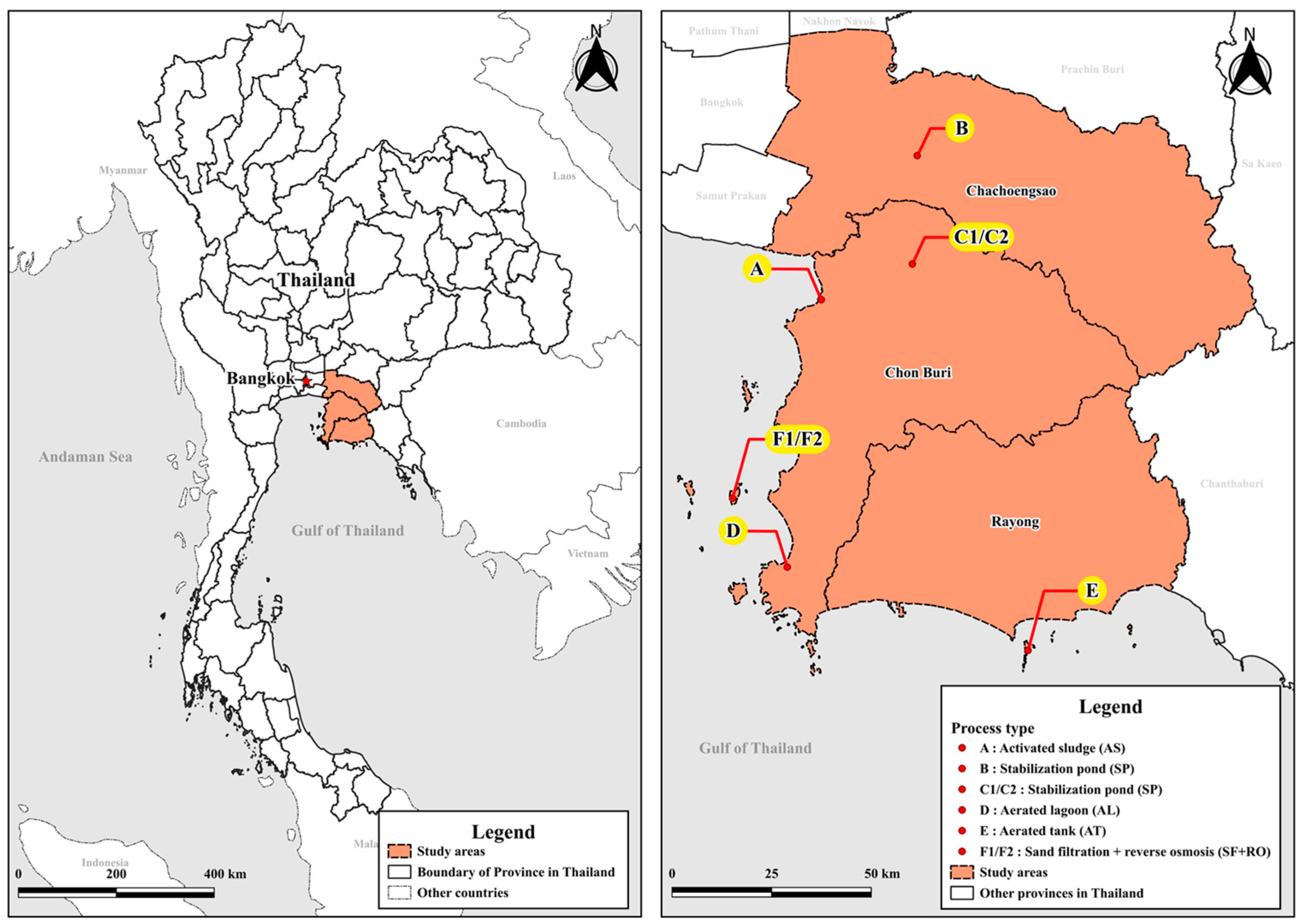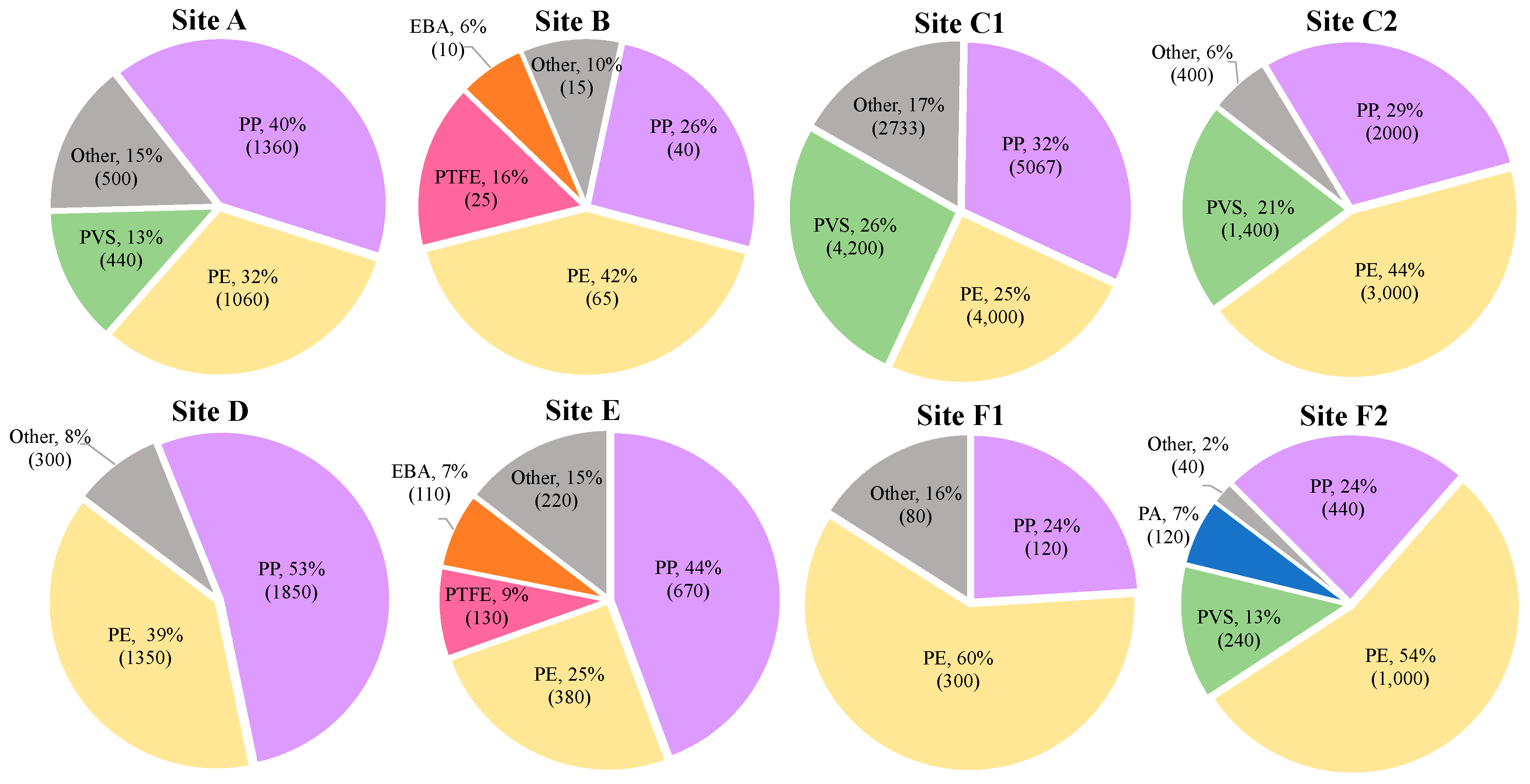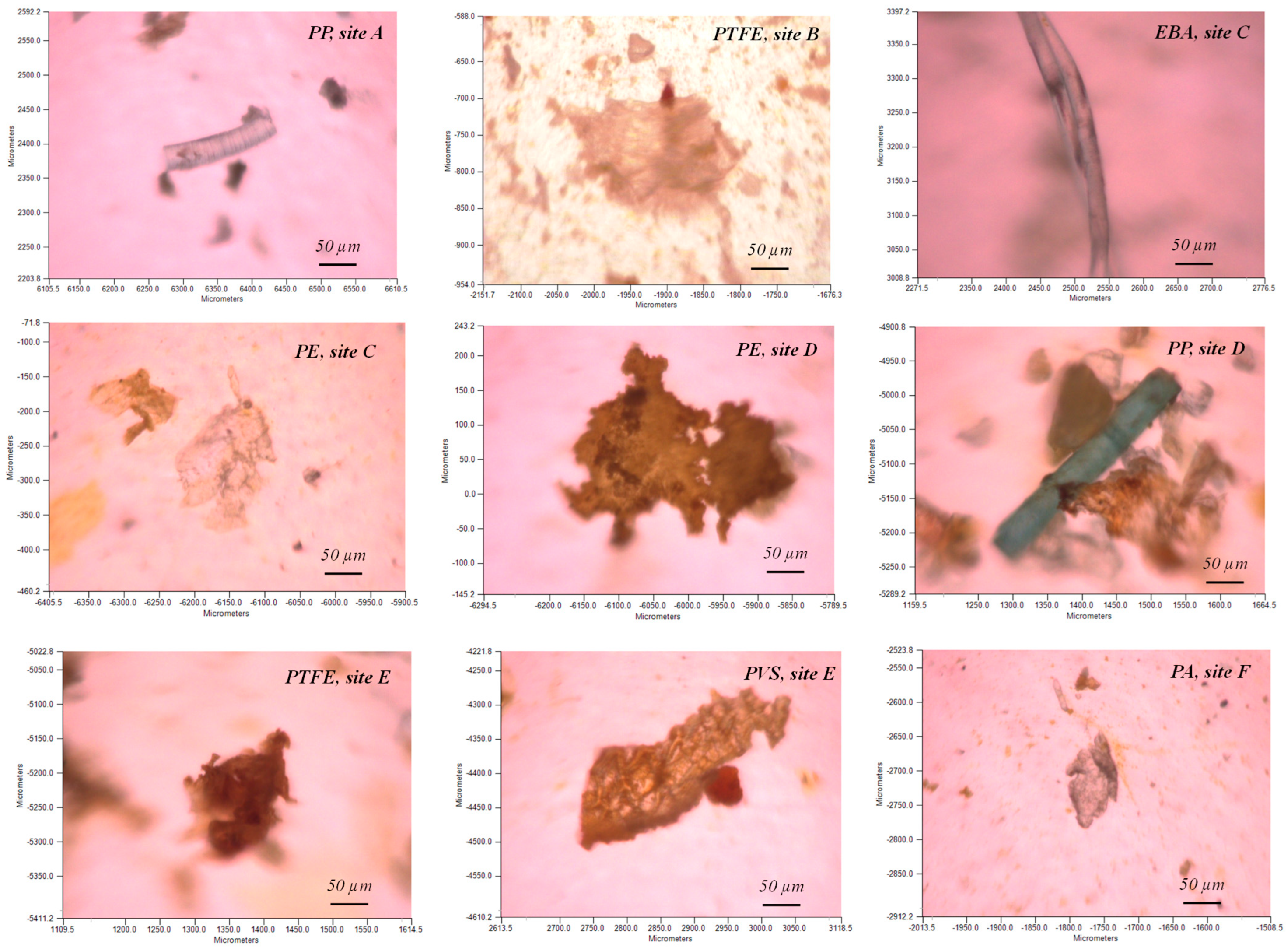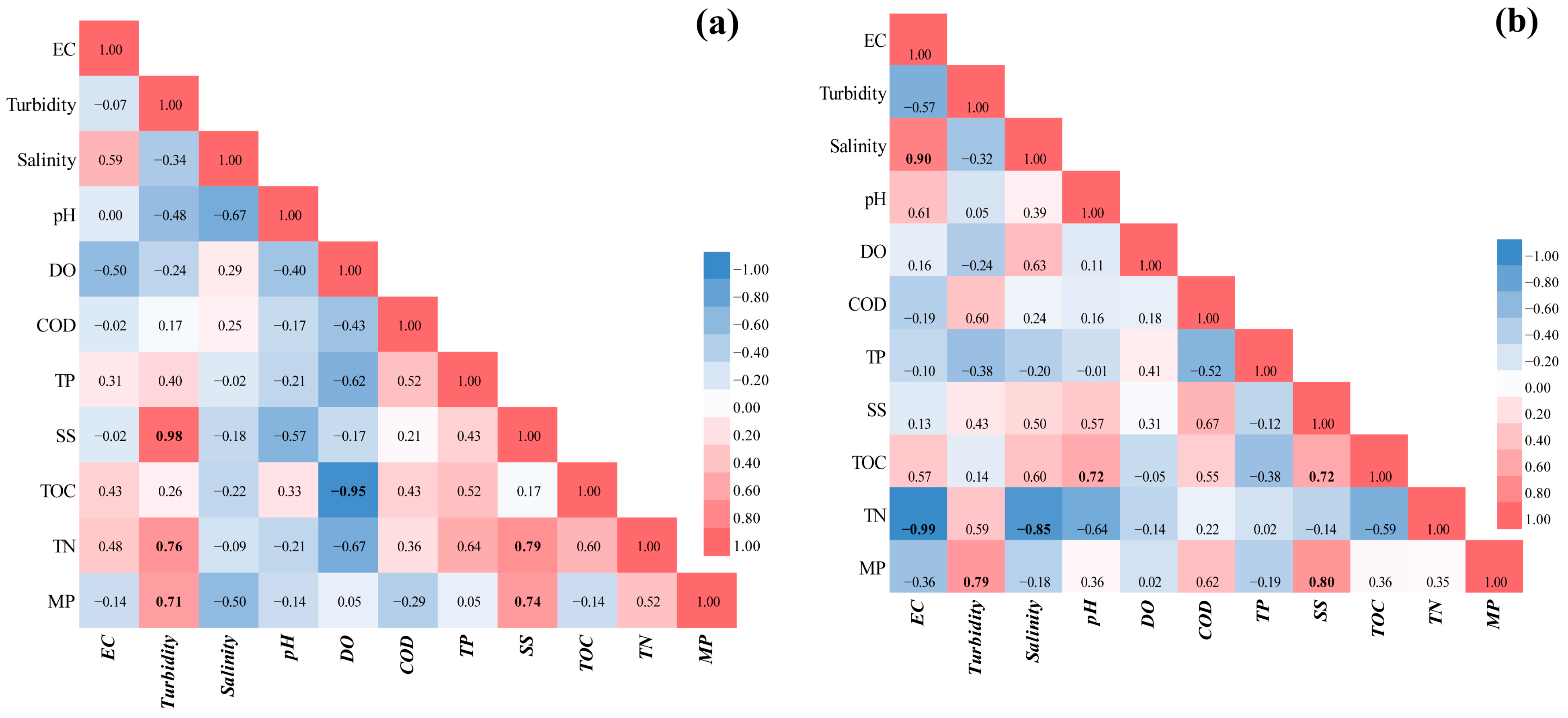Occurrence of Microplastics in Inland and Island Wastewater Treatment Plants and the Role of Suspended Solids as Monitoring Indicators
Abstract
1. Introduction
2. Materials and Methods
2.1. Study Area and Wastewater Treatment Plants
2.2. Sampling of Wastewater

2.3. Microplastic Pretreatment and Identification
2.4. Quality Assurance and Quality Control (QA/QC)
2.5. Physicochemical Water Quality Analysis
2.6. Statistical Analysis
3. Results and Discussion
3.1. Performance of WWTPs

3.2. Profiles and Size Distributions of MPs in Influent
3.3. MP Removal Efficiency of WWTPs
3.4. Correlation Between Water Quality Parameters and Microplastic Abundance

3.5. Limitations to the Proposed Approach and Future Perspectives
4. Conclusions
Supplementary Materials
Author Contributions
Funding
Data Availability Statement
Acknowledgments
Conflicts of Interest
References
- Mennekes, D.; Nowack, B. Predicting Microplastic Masses in River Networks with High Spatial Resolution at Country Level. Nat. Water 2023, 1, 523–533. [Google Scholar] [CrossRef]
- Andrady, A.L. Microplastics in the Marine Environment. Mar. Pollut. Bull. 2011, 62, 1596–1605. [Google Scholar] [CrossRef]
- Hale, R.C.; Seeley, M.E.; Guardia, M.J.L.; Mai, L.; Zeng, E.Y. A Global Perspective on Microplastics. J. Geophys. Res. Ocean. 2020, 125, e2018JC014719. [Google Scholar] [CrossRef]
- Iordachescu, L.; Nielsen, R.V.; Papacharalampos, K.; Barritaud, L.; Denieul, M.-P.; Plessis, E.; Baratto, G.; Julien, V.; Vollertsen, J. Point-Source Tracking of Microplastics in Sewerage Systems. Finding the Culprit. Water Res. 2024, 257, 121696. [Google Scholar] [CrossRef]
- Liu, W.; Zhang, J.; Liu, H.; Guo, X.; Zhang, X.; Yao, X.; Cao, Z.; Zhang, T. A Review of the Removal of Microplastics in Global Wastewater Treatment Plants: Characteristics and Mechanisms. Environ. Int. 2021, 146, 106277. [Google Scholar] [CrossRef]
- Dris, R.; Gasperi, J.; Rocher, V.; Saad, M.; Renault, N.; Tassin, B. Microplastic Contamination in an Urban Area: A Case Study in Greater Paris. Environ. Chem. 2015, 12, 592. [Google Scholar] [CrossRef]
- Sun, J.; Dai, X.; Wang, Q.; van Loosdrecht, M.C.M.; Ni, B.-J. Microplastics in Wastewater Treatment Plants: Detection, Occurrence and Removal. Water Res. 2019, 152, 21–37. [Google Scholar] [CrossRef] [PubMed]
- Carr, S.A.; Liu, J.; Tesoro, A.G. Transport and Fate of Microplastic Particles in Wastewater Treatment Plants. Water Res. 2016, 91, 174–182. [Google Scholar] [CrossRef]
- Bayo, J.; López-Castellanos, J.; Olmos, S. Membrane Bioreactor and Rapid Sand Filtration for the Removal of Microplastics in an Urban Wastewater Treatment Plant. Mar. Pollut. Bull. 2020, 156, 111211. [Google Scholar] [CrossRef]
- Dayal, L.; Yadav, K.; Dey, U.; Das, K.; Kumari, P.; Raj, D.; Mandal, R.R. Recent Advancement in Microplastic Removal Process from Wastewater—A Critical Review. J. Hazard. Mater. Adv. 2024, 16, 100460. [Google Scholar] [CrossRef]
- Ittisupornrat, S.; Namyuang, C.; Phetrak, A.; Sriromreun, P.; Theepharaksapan, S. Microplastic Contamination and Removal Efficiency in Greywater Treatment Using a Membrane Bioreactor. Front. Microbiol. 2025, 16, 1519230. [Google Scholar] [CrossRef] [PubMed]
- Lares, M.; Ncibi, M.C.; Sillanpää, M.; Sillanpää, M. Occurrence, Identification and Removal of Microplastic Particles and Fibers in Conventional Activated Sludge Process and Advanced MBR Technology. Water Res. 2018, 133, 236–246. [Google Scholar] [CrossRef]
- Sullivan, E.; Cole, M.; Atwood, E.C.; Lindeque, P.K.; Chin, P.T.; Martinez-Vicente, V. In Situ Correlation between Microplastic and Suspended Particulate Matter Concentrations in River-Estuary Systems Support Proxies for Satellite-Derived Estimates of Microplastic Flux. Mar. Pollut. Bull. 2023, 196, 115529. [Google Scholar] [CrossRef]
- Tadsuwan, K.; Babel, S. Microplastic Contamination in a Conventional Wastewater Treatment Plant in Thailand. Waste Manag. Res. 2021, 39, 754–761. [Google Scholar] [CrossRef]
- Kittipongvises, S.; Phetrak, A.; Hongprasith, N.; Lohwacharin, J. Unravelling Capability of Municipal Wastewater Treatment Plant in Thailand for Microplastics: Effects of Seasonality on Detection, Fate and Transport. J. Environ. Manag. 2022, 302, 113990. [Google Scholar] [CrossRef]
- Hongprasith, N.; Kittimethawong, C.; Lertluksanaporn, R.; Eamchotchawalit, T.; Kittipongvises, S.; Lohwacharin, J. IR Microspectroscopic Identification of Microplastics in Municipal Wastewater Treatment Plants. Environ. Sci. Pollut. Res. 2020, 27, 18557–18564. [Google Scholar] [CrossRef] [PubMed]
- Tontisirin, N.; Anantsuksomsri, S. Economic Development Policies and Land Use Changes in Thailand: From the Eastern Seaboard to the Eastern Economic Corridor. Sustainability 2021, 13, 6153. [Google Scholar] [CrossRef]
- Bissen, R.; Chawchai, S. Microplastics on Beaches along the Eastern Gulf of Thailand—A Preliminary Study. Mar. Pollut. Bull. 2020, 157, 111345. [Google Scholar] [CrossRef] [PubMed]
- Phaksopa, J.; Worachananant, S.; Thamrongnawasawat, T.; Tanapivattanakul, K.; Kumnuandao, S.; Chamcha-Em, T.; Khamrueang, A.; Chaimongkol, T. Microplastic Pollution and Risk Assessment around Coral Reefs of the Eastern Part, Thailand. Environ. Sci. Pollut. Res. Int. 2025, 32, 12441–12454. [Google Scholar] [CrossRef] [PubMed]
- Bayarkhuu, B.; Byun, J. Optimization of Coagulation and Sedimentation Conditions by Turbidity Measurement for Nano- and Microplastic Removal. Chemosphere 2022, 306, 135572. [Google Scholar] [CrossRef]
- Zhou, Q.; Tu, C.; Yang, J.; Fu, C.; Li, Y.; Waniek, J.J. Trapping of Microplastics in Halocline and Turbidity Layers of the Semi-Enclosed Baltic Sea. Front. Mar. Sci. 2021, 8, 761566. [Google Scholar] [CrossRef]
- Razeghi, N.; Hamidian, A.H.; Wu, C.; Zhang, Y.; Yang, M. Microplastic Sampling Techniques in Freshwaters and Sediments: A Review. Environ. Chem. Lett. 2021, 19, 4225–4252. [Google Scholar] [CrossRef]
- Masura, J.; Baker, J.; Foster, G.; Arthur, C. Laboratory Methods for the Analysis of Microplastics in the Marine Environment: Recommendations for Quantifying Synthetic Particles in Waters and Sediments; NOAA Marine Debris Division: Silver Spring, MD, USA, 2015. [Google Scholar]
- Vibhatabandhu, P.; Prachayakul, T.; Tang-siri, J.; Benmas, P.; Srithongouthai, S.; Kanokkantapong, V. Effect of Tidal Current on the Settling and Accumulation of Microplastics in the Chao Phraya River Estuary, Thailand. Mar. Pollut. Bull. 2024, 200, 116068. [Google Scholar] [CrossRef]
- Miserli, K.; Konstantinou, I. Determination of Microplastics in Municipal Wastewater Treatment Plant Effluents and Sludge Using Micro-Raman Spectroscopy. Water Emerg. Contam. Nanoplastics 2025, 4. [Google Scholar] [CrossRef]
- Zhang, K.; Shi, H.; Peng, J.; Wang, Y.; Xiong, X.; Wu, C.; Lam, P.K.S. Microplastic Pollution in China’s Inland Water Systems: A Review of Findings, Methods, Characteristics, Effects, and Management. Sci. Total Environ. 2018, 630, 1641–1653. [Google Scholar] [CrossRef] [PubMed]
- Wesch, C.; Elert, A.M.; Wörner, M.; Braun, U.; Klein, R.; Paulus, M. Assuring Quality in Microplastic Monitoring: About the Value of Clean-Air Devices as Essentials for Verified Data. Sci. Rep. 2017, 7, 5424. [Google Scholar] [CrossRef]
- Eaton, A.D.; Baird, R.B.; Rice, E.W.; Bridgewater, A. Standard Methods for the Examination of Water and Wastewater, 23rd ed.; American Public Health Association: Washington, DC, USA, 2017; ISBN 978-0-87553-287-5. [Google Scholar]
- Cox, D.R.; Spjøtvoll, E.; Johansen, S.; van Zwet, W.R.; Bithell, J.F.; Barndorff-Nielsen, O.; Keuls, M. The Role of Significance Tests [with Discussion and Reply]. Scand. J. Stat. 1977, 4, 49–70. [Google Scholar]
- Metcalf, E. Wastewater Engineering: Treatment and Resource Recovery, 5th ed.; McGraw-Hill: New York, NY, USA, 2014. [Google Scholar]
- Wiesmann, U.; Choi, I.S.; Dombrowski, E.M. Fundamentals of Biological Wastewater Treatment; Wiley-VCH: Weinheim, Germany, 2006; p. 362. ISBN 978-3-527-31219-1. [Google Scholar]
- Tang, S.L.; Yue, D.P.T.; Li, X.Z. Comparison of Engineering Costs of Raw Freshwater, Reclaimed Water and Seawater for Toilet Flushing in Hong Kong. Water Environ. J. 2006, 20, 240–247. [Google Scholar] [CrossRef]
- Limsakul, A.; Kammuang, A.; Paengkaew, W.; Sooktawee, S.; Aroonchan, N. Changes in Slow-Onset Climate Events in Thailand. Environ. Eng. Res. 2024, 29, 220784. [Google Scholar] [CrossRef]
- Zhao, Y.; Zhuang, X.; Ahmad, S.; Sung, S.; Ni, S.Q. Biotreatment of High-Salinity Wastewater: Current Methods and Future Directions. World J. Microbiol. Biotechnol. 2020, 36, 37. [Google Scholar] [CrossRef]
- Kim, J.; Wu, B.; Jeong, S.; Jeong, S.; Kim, M. Recent Advances of Membrane-Based Hybrid Membrane Bioreactors for Wastewater Reclamation. Front. Membr. Sci. Technol. 2024, 3, 1361433. [Google Scholar] [CrossRef]
- Ittisupornrat, S.; Theepharaksapan, S.; Krasaesueb, N.; Phetrak, A. Impact of Saline Valorization in Contaminated Municipal Wastewater on the Treatment Performance and Bacterial Community Dynamics of a Membrane Bioreactor. J. Chem. Technol. Biotechnol. 2023, 98, 633–641. [Google Scholar] [CrossRef]
- Thompson, R.C.; Moore, C.J.; vom Saal, F.S.; Swan, S.H. Plastics, the Environment and Human Health: Current Consensus and Future Trends. Philos. Trans. R. Soc. B Biol. Sci. 2009, 364, 2153–2166. [Google Scholar] [CrossRef]
- Andrady, A.L. The Plastic in Microplastics: A Review. Mar. Pollut. Bull. 2017, 119, 12–22. [Google Scholar] [CrossRef]
- Song, K.; Li, L. Occurrence of Microplastics in Wastewater Treatment Plants. In Microplastics in Urban Water Management; John Wiley & Sons: Weinheim, Germany, 2023; pp. 91–117. [Google Scholar] [CrossRef]
- Geyer, R.; Jambeck, J.R.; Law, K.L. Production, Use, and Fate of All Plastics Ever Made. Sci. Adv. 2017, 3, e1700782. [Google Scholar] [CrossRef]
- Onay, H.; Minaz, M.; Ak, K.; Er, A.; Emanet, M.; Karslı, B.; Bilgin, S. Decade of Microplastic Alteration in the Southeastern Black Sea: An Example of Seahorse Gastrointestinal Tracts. Environ. Res. 2023, 218, 115001. [Google Scholar] [CrossRef]
- Jessieleena, A.; Rathinavelu, S.; Velmaiel, K.E.; John, A.A.; Nambi, I.M. Residential Houses—A Major Point Source of Microplastic Pollution: Insights on the Various Sources, Their Transport, Transformation, and Toxicity Behaviour. Environ. Sci. Pollut. Res. 2023, 30, 67919–67940. [Google Scholar] [CrossRef] [PubMed]
- Vibhatabandhu, P.; Srithongouthai, S. Influence of Seasonal Variations on the Distribution Characteristics of Microplastics in the Surface Water of the Inner Gulf of Thailand. Mar. Pollut. Bull. 2022, 180, 113747. [Google Scholar] [CrossRef] [PubMed]
- Reddy, A.S.; Nair, A.T. The Fate of Microplastics in Wastewater Treatment Plants: An Overview of Source and Remediation Technologies. Environ. Technol. Innov. 2022, 28, 102815. [Google Scholar] [CrossRef]
- Extrand, C.W.; Moon, S.I. Using the Flotation of a Single Sphere to Measure and Model Capillary Forces. Langmuir 2009, 25, 6239–6244. [Google Scholar] [CrossRef] [PubMed]
- Kiattisaksiri, P.; Eaktasang, N.; Pasukphun, N.; Youdee, K.; Suma, Y. Occurrence of Microplastics across Seasonal Variations in a Municipal Wastewater Treatment Plant in Thailand. Trends Sci. 2025, 22, 9931. [Google Scholar] [CrossRef]
- Chukwuka, A.V.; Adegboyegun, A.D.; Adeogun, A.O. Algal Bloom-Mediated Microplastic Dispersion in Coastal Areas of West Africa: Integrated Insights and Risk Projections from Molecular Models and Remote-Sensed Evaluations. J. Hazard. Mater. 2025, 489, 137590. [Google Scholar] [CrossRef]
- Lv, X.; Dong, Q.; Zuo, Z.; Liu, Y.; Huang, X.; Wu, W.-M. Microplastics in a Municipal Wastewater Treatment Plant: Fate, Dynamic Distribution, Removal Efficiencies, and Control Strategies. J. Clean. Prod. 2019, 225, 579–586. [Google Scholar] [CrossRef]
- Pittura, L.; Foglia, A.; Akyol, Ç.; Cipolletta, G.; Benedetti, M.; Regoli, F.; Eusebi, A.L.; Sabbatini, S.; Tseng, L.Y.; Katsou, E.; et al. Microplastics in Real Wastewater Treatment Schemes: Comparative Assessment and Relevant Inhibition Effects on Anaerobic Processes. Chemosphere 2021, 262, 128415. [Google Scholar] [CrossRef]
- Talvitie, J.; Mikola, A.; Koistinen, A.; Setälä, O. Solutions to Microplastic Pollution—Removal of Microplastics from Wastewater Effluent with Advanced Wastewater Treatment Technologies. Water Res. 2017, 123, 401–407. [Google Scholar] [CrossRef] [PubMed]
- Ziajahromi, S.; Neale, P.A.; Rintoul, L.; Leusch, F.D.L. Wastewater Treatment Plants as a Pathway for Microplastics: Development of a New Approach to Sample Wastewater-Based Microplastics. Water Res. 2017, 112, 93–99. [Google Scholar] [CrossRef] [PubMed]
- Michielssen, M.R.; Michielssen, E.R.; Ni, J.; Duhaime, M.B. Fate of Microplastics and Other Small Anthropogenic Litter (SAL) in Wastewater Treatment Plants Depends on Unit Processes Employed. Environ. Sci. Water Res. Technol. 2016, 2, 1064–1073. [Google Scholar] [CrossRef]
- Reza, T.; Mohamad Riza, Z.H.; Sheikh Abdullah, S.R.; Abu Hasan, H.; ‘Izzati Ismail, N.; Othman, A.R. Microplastic Removal in Wastewater Treatment Plants (WWTPs) by Natural Coagulation: A Literature Review. Toxics 2024, 12, 12. [Google Scholar] [CrossRef]
- Acarer, S. A Review of Microplastic Removal from Water and Wastewater by Membrane Technologies. Water Sci. Technol. 2023, 88, 199–219. [Google Scholar] [CrossRef]
- Tarte, J.V.; Ahmed, M.B.; Tra, V.-T.; Wang, Q.; Johir, M.A.H.; Nghiem, L.D. Large Scale Microplastic Fibre Analysis in Wastewater: A Comprehensive Review and Recommendations. Curr. Pollut. Rep. 2025, 11, 49. [Google Scholar] [CrossRef]
- Prata, J.C.; da Costa, J.P.; Lopes, I.; Duarte, A.C.; Rocha-Santos, T. Environmental Exposure to Microplastics: An Overview on Possible Human Health Effects. Sci. Total Environ. 2020, 702, 134455. [Google Scholar] [CrossRef] [PubMed]
- Nafea, T.H.; Al-Maliki, A.J.; Al-Tameemi, I.M. Sources, Fate, Effects, and Analysis of Microplastic in Wastewater Treatment Plants: A Review. Environ. Eng. Res. 2024, 29. [Google Scholar] [CrossRef]
- Xu, Q.; Ni, B.-J. Microplastics Removal and Degradation in Urban Water Systems. In Microplastics in Urban Water Management; John Wiley & Sons, Ltd.: Hoboken, NJ, USA, 2022; pp. 211–242. ISBN 978-1-119-75937-9. [Google Scholar]
- Suanluang, S.; Vibhatabandhu, P.; Srithongouthai, S. Spatial Distribution and Potential Ecological Risk of Microplastics in Surface Sediments of the Inner Gulf of Thailand. Appl. Environ. Res. 2025, 47, 1–17. [Google Scholar] [CrossRef]




| Country | Treatment Process | Influent (MP L−1) | Effluent (MP L−1) | Removal (%) | Dominant Polymer | Source |
|---|---|---|---|---|---|---|
| Asia | ||||||
| Thailand | SP | 1.30 ± 1.61 | 0.22 ± 0.42 | 75–100 | Fragment (PET, PP, PE) | [46] |
| Thailand | SBR, OD, CAS | 12.2 | 2.0 | 84 | Fiber (PES, 18%), PE (13%), Polyacrylate (12%), PP (9%) | [16] |
| China | OD | 0.28 ± 0.02 | 0.13 ± 0.01 | 53.6 (number)/97 (mass) | PET (47%), PS (20%), PE (18%), PP (15%) | [48] |
| Europe | ||||||
| Italy | CAS | 3.6 | 0.76–1.9 | 85.7 | Fiber (PE, PET) | [49] |
| Finland | MBR | 6.9 ± 1.0 | 0.005 ± 0.004 | 99.9 | Polyester (60%), PE (14%), Polyacrylate (7%) | [50] |
| Australia | AS + SF + RO | 12–117 | 0.21–1.5 | 98.3–99.8 | Fiber, Fragment (PE, PET) | [51] |
| USA | AS/SF/AnMBR | 133 ± 36/94 ± 18 | 5.9/0.5 | 95.6–99.4 | Fiber (44–83%) > Fragment > Paint chip | [52] |
| Data Source | Model Type | Regression Equation | Adj. R2 | p-Value |
|---|---|---|---|---|
| Influent Sample | TSS | 0.513 | 0.028 * | |
| Turbidity | 0.174 | 0.167 | ||
| TSS and Turbidity | 0.918 | 0.001 * | ||
| Effluent Sample | TSS | 0.914 | 0.000 * | |
| Turbidity | 0.857 | 0.001 * | ||
| TSS and Turbidity | 0.914 | 0.001 * |
Disclaimer/Publisher’s Note: The statements, opinions and data contained in all publications are solely those of the individual author(s) and contributor(s) and not of MDPI and/or the editor(s). MDPI and/or the editor(s) disclaim responsibility for any injury to people or property resulting from any ideas, methods, instructions or products referred to in the content. |
© 2025 by the authors. Licensee MDPI, Basel, Switzerland. This article is an open access article distributed under the terms and conditions of the Creative Commons Attribution (CC BY) license (https://creativecommons.org/licenses/by/4.0/).
Share and Cite
Theepharaksapan, S.; Sriromreun, P.; Kiattisaksiri, P.; Phetrak, A.; Molee, C.; Ittisupornrat, S. Occurrence of Microplastics in Inland and Island Wastewater Treatment Plants and the Role of Suspended Solids as Monitoring Indicators. Water 2025, 17, 3330. https://doi.org/10.3390/w17223330
Theepharaksapan S, Sriromreun P, Kiattisaksiri P, Phetrak A, Molee C, Ittisupornrat S. Occurrence of Microplastics in Inland and Island Wastewater Treatment Plants and the Role of Suspended Solids as Monitoring Indicators. Water. 2025; 17(22):3330. https://doi.org/10.3390/w17223330
Chicago/Turabian StyleTheepharaksapan, Suthida, Paranee Sriromreun, Pradabduang Kiattisaksiri, Athit Phetrak, Chalintorn Molee, and Suda Ittisupornrat. 2025. "Occurrence of Microplastics in Inland and Island Wastewater Treatment Plants and the Role of Suspended Solids as Monitoring Indicators" Water 17, no. 22: 3330. https://doi.org/10.3390/w17223330
APA StyleTheepharaksapan, S., Sriromreun, P., Kiattisaksiri, P., Phetrak, A., Molee, C., & Ittisupornrat, S. (2025). Occurrence of Microplastics in Inland and Island Wastewater Treatment Plants and the Role of Suspended Solids as Monitoring Indicators. Water, 17(22), 3330. https://doi.org/10.3390/w17223330






